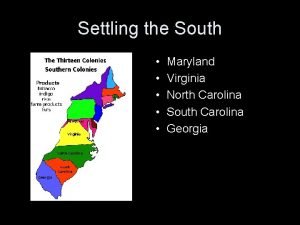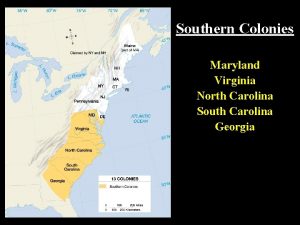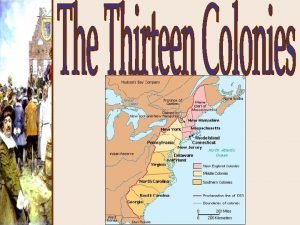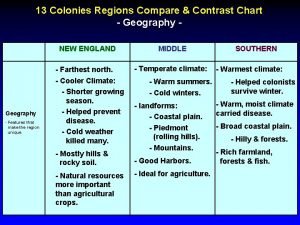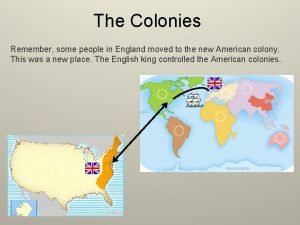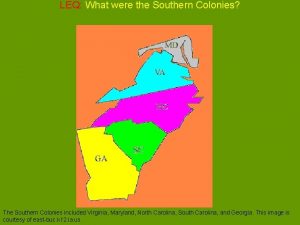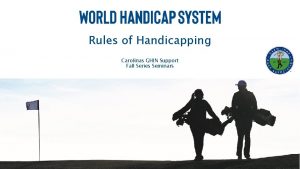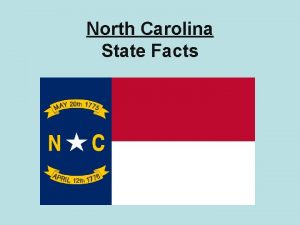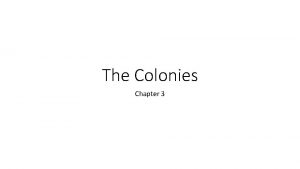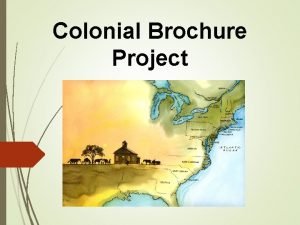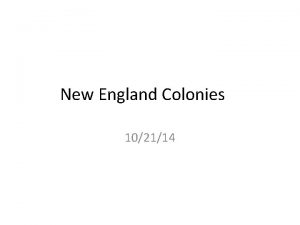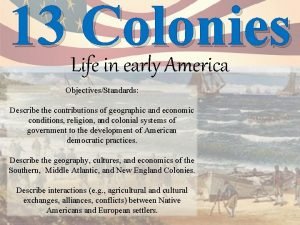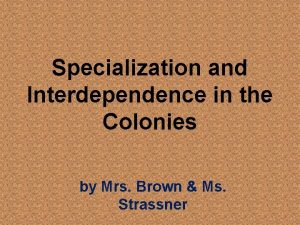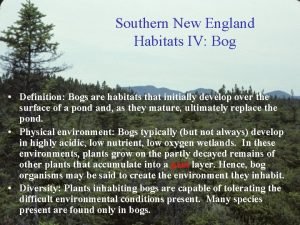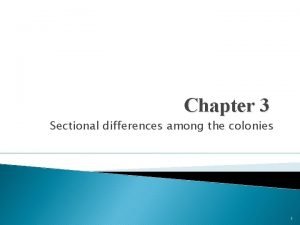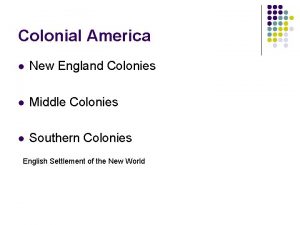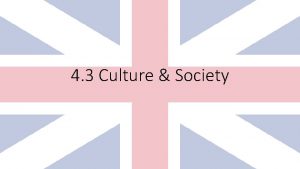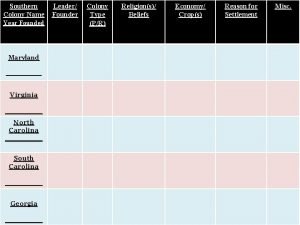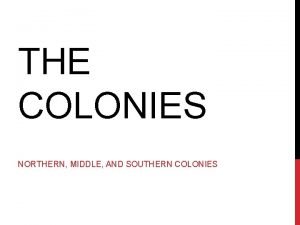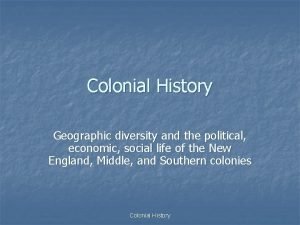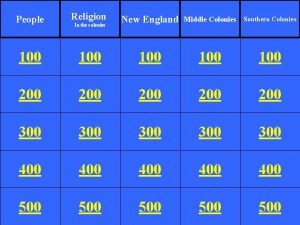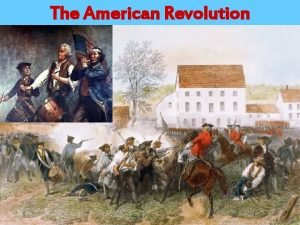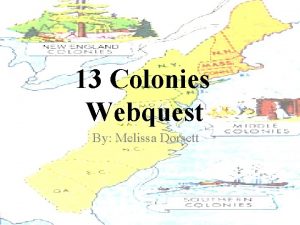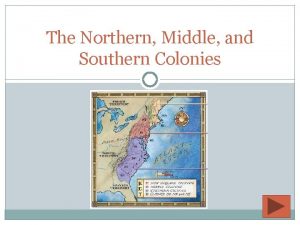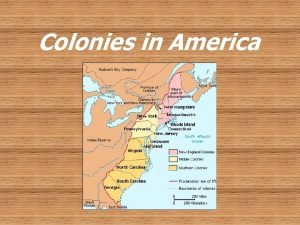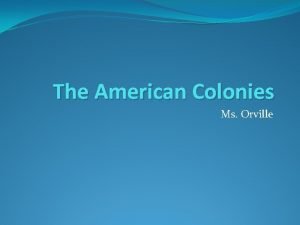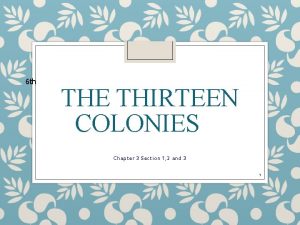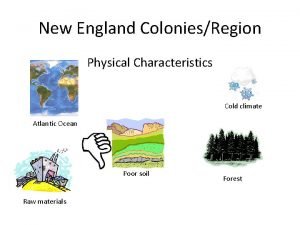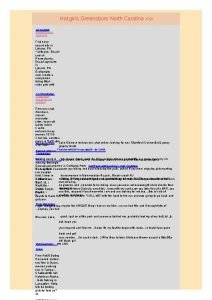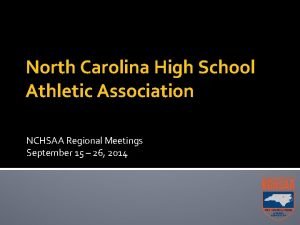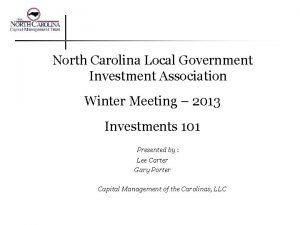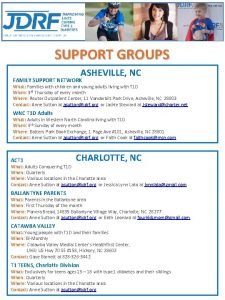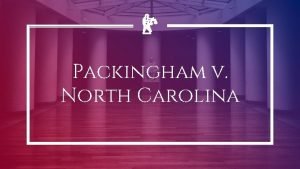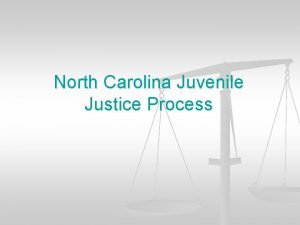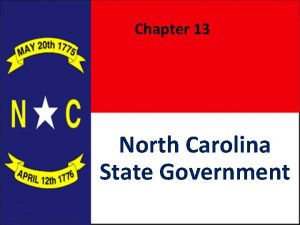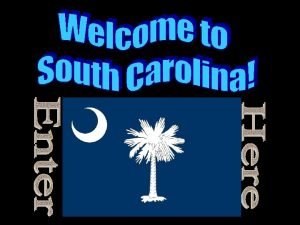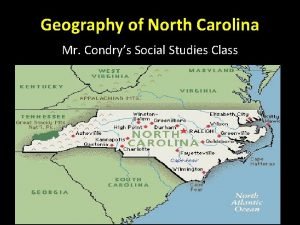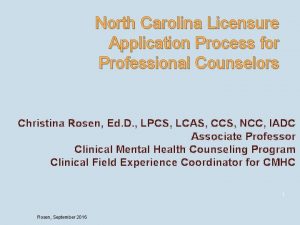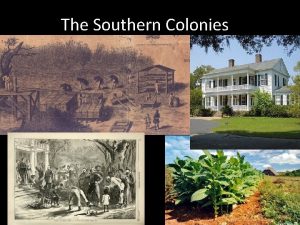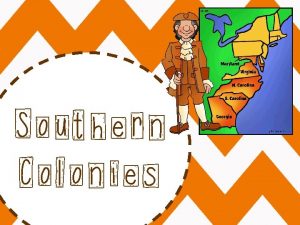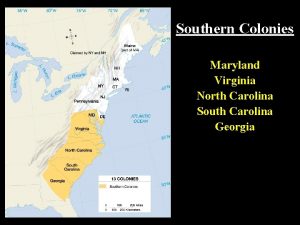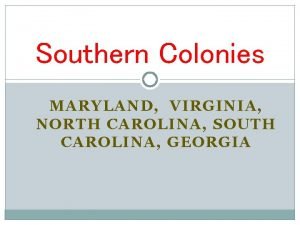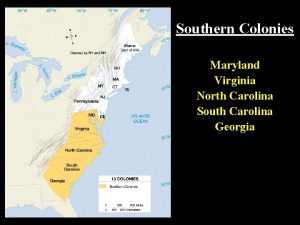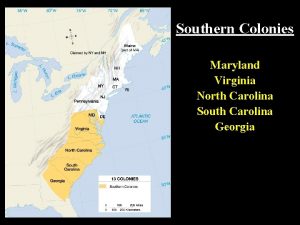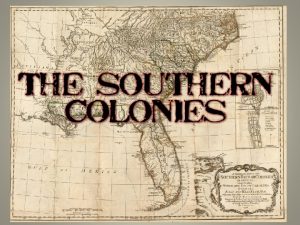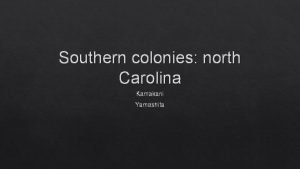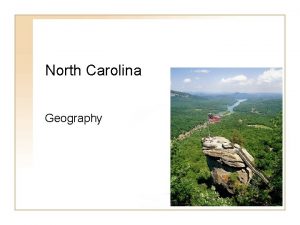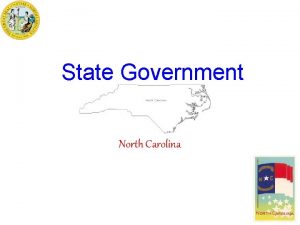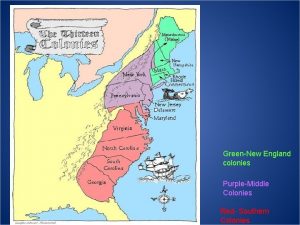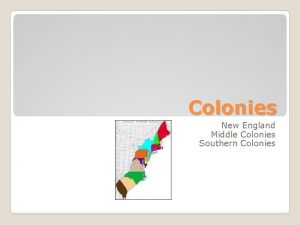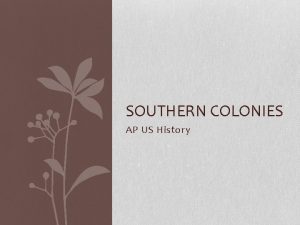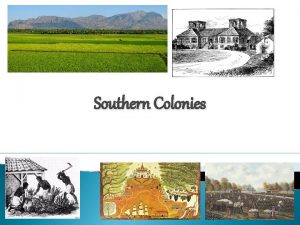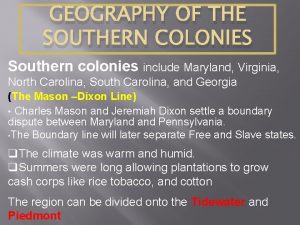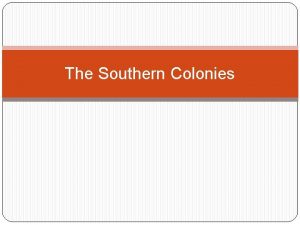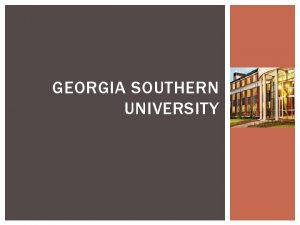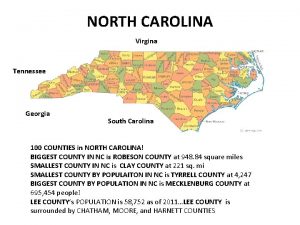The Southern Colonies The Carolinas Georgia North Carolina



















































- Slides: 51

The Southern Colonies The Carolina’s & Georgia

North Carolina • Farmers from Virginia established small, self-sufficient tobacco farms. • • The region lacked good harbors which led to fewer large plantations.

South Carolina • With a warm climate and access to good ports, South Carolina’s plantation economy grew. • South Carolina became known for its large RICE plantations.

Georgia • Founded in 1732 Georgia was the last of the British colonies. • First colonists arrive in 1733 and settle along the Savannah River on Yamacraw Bluff. • Reasons for establishment: – Charity – Economics – Defense

The Middle Colonies New York, New Jersey, Delaware & Pennsylvania

The Middle Colonies

Middle Colonies • Immigrants were attracted to the available land a more tolerant religious atmosphere of the Middle Colonies. • This was in contrast to the New England Colonies, whose populations increased mainly through birthrate.


New York = New Amsterdam • New York was settled by the Dutch, who called it New Amsterdam • In 1664, the British conquered the colony from the Dutch and renamed it New York.

New York • NY became a center of trade & commerce (located on the Hudson River). • With members of various British & Dutch churches, New York tolerated different religions.

New Jersey • New Jersey enticed settlement with generous land offers and allowed for religious freedom and an assembly.

William Penn & Pennsylvania • William Penn was a Quaker and a champion for democracy and religious freedom. • He believed Pennsylvania was “The Holy Experiment” and wanted the colony to provide a refuge for Quakers and other persecuted people. • Penn advertised his colony in Europe to gain new settlers.

William Penn & Pennsylvania • His beliefs in treating people fairly extended to his business dealings with the Native Americans. • Pennsylvania territory grew through land purchases instead of wars and fighting for control of the territory.

Delaware • Originally part of Pennsylvania, Delaware was granted it’s own assembly by William Penn in 1702.

The Settlement of New England


New England • Many of the New England settlers were Puritans escaping from religious persecution in England. • The region’s northern location and poor farmland meant that its winters were cold and difficult.

Pilgrims • What is the difference between the Pilgrims & the Puritans? • Make a chart on your paper!!

The Separatists became “Pilgrims” when they formed a joint-stock company, gained a charter, & created the Plymouth colony in America

Before landing in America, the Pilgrims created the Mayflower Compact agreeing to work together as a “civil body politick”… …The Mayflower Compact was the first example of self-government in America

When the Pilgrims founded Plymouth in 1620, they faced disease & hunger The Pilgrims received help from local natives like Squanto & Massasoit… …and celebrated the first Thanksgiving to honor the local Indians

When the Separatist Pilgrims came to America, the Puritans remained within the Church of England But when the Catholic King Charles I came to power, Puritans felt the time was right to leave Britain In 1630, Puritans arrived in Boston & created the New England colony of Massachusetts

From 1630 to 1640, Puritan leader John Winthrop led 16, 000 Puritans to the Massachusetts Bay colony as part of the “Great Migration” John Winthrop wanted to build Boston as a “city on a hill” to be a model to other Christians


Religious Persecution • The Puritans who settled in Massachusetts wanted freedom to worship as they pleased. • However, they required those who settled in their colony to follow Puritan theology.

Religious Persecution • Puritan religious dissenters (people who didn’t follow their faith) were banished from the Massachusetts colony. • Two members banished from Puritan Massachusetts were Roger Williams (founded R. I. ) & Anne Hutchinson. • Rhode Island, Pennsylvania, & New Hampshire were settled as havens of religious freedom from the Puritans.

Religious Tensions • Church membership was on a decline in Puritan Massachusetts. To fix this they passed the half-way covenant. • The half-way covenant provided partial church membership for the children and grandchildren of original Puritans, regardless of their conversion experience. – They hoped that partial church membership would get them more involved and eventually encourage them to become full members of the church.

New England Government • The Mayflower Compact was the first attempt at self government. (Massachusetts) • In New England, they established an elected legislature. • They held town meetings where tax paying citizens met to discuss and vote on issues. • True Puritan power rested in the church leaders.

Paranoia hits Salem, Mass. • Claiming that they were possessed by the devil, several girls accused the towns people in Salem of being witches. – This event became known as the Salem Witch Trials Video Clip

The Salem Witch Trials • In a series of court hearings, over 150 Massachusetts colonists accused of witchcraft were tried. • 29 of whom were convicted, & 19 were hanged. • At least 6 more died in prison.

Salem • The Puritans had created a theocracy in which the church could rule in civil matters, even sentencing someone to death for violations of church beliefs. • The magistrates used several methods, none of which would stand up in a court of law today, to determine the guilt or innocence of someone who was accused of witchcraft.

• As the Massachusetts colony grew, it spawned four new colonies: • New Hampshire • Rhode Island • New Haven • Connecticut created the first written constitution in U. S. history called The Fundamental Orders of Connecticut

Relationship with Natives • At first relations were good. – A Treaty was signed between the Pilgrims and the Wampanoag Indians. • However, things will change…

Relationship with Natives • As the New England colonies expanded into new lands, conflicts with Indians arose • The Pequot War in 1637 was the 1 st major British -led attack on Indians & led to the death of 600 Indians

King Phillip’s War (1675 -1676) • The only hope for Native Americans to resist white settlers encroachment on their land was to UNITE. • Metacom (King Phillip to white settlers) united the natives in his area and staged attacks on white settlements throughout New England. • Frontier settlers pushed back to Boston.

King Phillip’s War (1675 -1676)

King Phillip’s War (1675 -1676) • The war ended in failure for the natives. – Metacom beheaded – His son & wife were sold into slavery. – There was never a serious threat in New England again.

Dominion of New England

Dominion of New England • 1686 - created to: • 1 -to strengthen defense • 2 -regain control over America • Navigation Acts- colonists could only ship goods on British ships (limited trade) • Sir Edmund Andros- leader- not liked • Put restrictions on lifestyle of Puritans • Glorious Revolution put an end to his rule

Dominion of New England • Massachusetts gained a new charter • All men can vote, not just church members • Moved Massachusetts towards democracy

Massachusetts Bay • Massachusetts Bay began as a proprietary colony controlled by the Massachusetts Bay Company. • The colony had disagreements with England, however, mainly due to the Puritan clergy refusing rights to other religious groups such as Anglicans, Quakers, and Catholics. • In 1691, Massachusetts was chartered as a royal colony —a colony whose governor is appointed by the monarch. – This combined the Plymouth & Massachusetts Bay Colonies

Geography, Transportation, & Economy

13 English Colonies • Though the colonies were all English, the backgrounds and motives of the people who settled them were diverse. • Regional differences in both climate and natural resources guaranteed that each section would have a distinct culture. • • It is no surprise that New England—composed of Puritan refugees trying to farm on difficult soil—would develop differently than Virginia—a proprietary-turned-


Climate & Geography • The northern and southern climates and geography influenced the types of crops grown. • Depending on the crop, different levels of labor were required. • Southern plantations became more dependent on slavery to make a profit from their crops.

Agriculture

New England • In the early days of colonial North America, New England was considered the poorest region. • This was due mostly to the cold climate and rocky soil. • Highest life expectancy in the colonies (Smaller population) • Highest literacy rate

Middle Colonies • Economic development (Agriculture or trade) of the Middle Colonies depended upon the geography and climate of the colony. • Some middle colonies resembled Southern Colonies, some resembled New England

Venn Diagram • Create a Venn Diagram comparing and contrasting the New England Colonies to the Southern Colonies.

Quick discussion: Based on these images, how were the New England colonies different from Virginia?

Massachusetts was a different colony from Virginia: Puritans came to America Puritan settlers usually came as families for religious freedom Settlers sacrificed for the common good, built schools, & focused on subsistence farming New England was a more healthy place to live than Virginia so colonists lived longer
 Maryland virginia north carolina south carolina and georgia
Maryland virginia north carolina south carolina and georgia Virginia, maryland, north carolina, south carolina, georgia
Virginia, maryland, north carolina, south carolina, georgia North carolina marschland
North carolina marschland Slavery in the 13 colonies chart
Slavery in the 13 colonies chart Northern colonies
Northern colonies What is this image
What is this image Course handicap formula
Course handicap formula North carolina state motto
North carolina state motto Southern colonies
Southern colonies Colonial brochure project
Colonial brochure project Religion southern colonies
Religion southern colonies New england, middle and southern colonies comparison chart
New england, middle and southern colonies comparison chart New england colonies facts
New england colonies facts Chapter 3 lesson 4 the southern colonies
Chapter 3 lesson 4 the southern colonies Southern colonies specialization
Southern colonies specialization Economy of southern colonies
Economy of southern colonies Southern colonies definition
Southern colonies definition Economy of southern colonies
Economy of southern colonies L
L New england mid atlantic and southern colonies
New england mid atlantic and southern colonies Southern colonies society/culture
Southern colonies society/culture Southern colonies founder
Southern colonies founder Northern middle southern colonies
Northern middle southern colonies Southern colonies geography
Southern colonies geography Middle colonies religion
Middle colonies religion What country
What country Characteristics of the southern colonies
Characteristics of the southern colonies Southern colonies webquest
Southern colonies webquest Northern middle southern colonies
Northern middle southern colonies Economy of middle colonies
Economy of middle colonies Southern colonies
Southern colonies Southern colonies
Southern colonies Southern colonies physical characteristics
Southern colonies physical characteristics Colonial entertainment
Colonial entertainment Caitlin driscoll
Caitlin driscoll Chapter 14 lesson 1 the industrial north
Chapter 14 lesson 1 the industrial north Greensboro sexshop
Greensboro sexshop Nchsaa board of directors
Nchsaa board of directors Local government investment pool services north carolilna
Local government investment pool services north carolilna Mutual self help housing
Mutual self help housing Cape fear valley pharmacy residency
Cape fear valley pharmacy residency Family support network of north carolina
Family support network of north carolina Computer science unc chapel hill
Computer science unc chapel hill Callie zipple
Callie zipple North carolina juvenile justice process
North carolina juvenile justice process Chapter 13: north carolina state government
Chapter 13: north carolina state government North carolina geographic regions
North carolina geographic regions North carolina relative location
North carolina relative location North carolina landmarks
North carolina landmarks North carolina sunshine laws
North carolina sunshine laws Lpca application
Lpca application Mcnc north carolina
Mcnc north carolina
